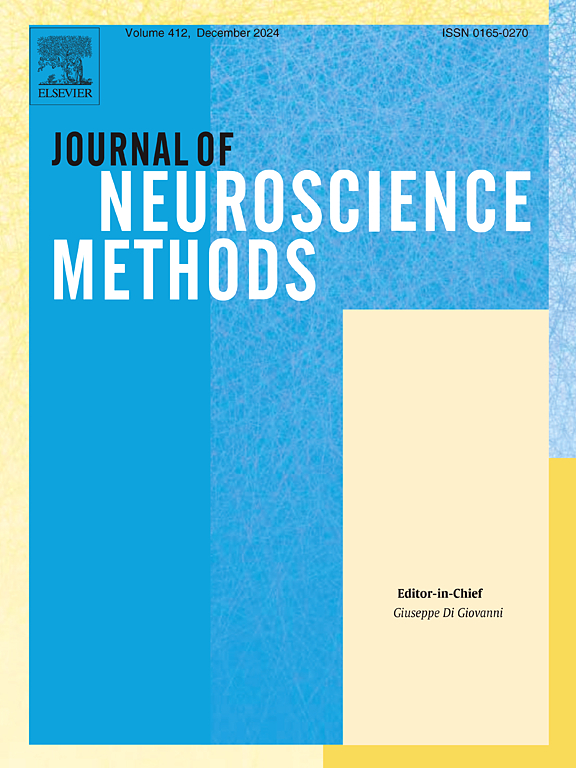视觉刺激时传导信号变化的功能磁共振成像研究
IF 2.7
4区 医学
Q2 BIOCHEMICAL RESEARCH METHODS
引用次数: 0
摘要
背景:虽然血氧水平依赖性(BOLD)功能磁共振成像(fMRI)是一种标准方法,但主要的BOLD信号主要来自血管内。基于磁共振电特性断层扫描(MREPT)的 fMRI 信号可为离子浓度和迁移率的改变所引起的电活动提供额外的见解:共有 30 名年轻、健康的志愿者参加了两项独立实验,在 3T 磁共振成像上使用 BOLD 和 MREPT 技术进行视觉刺激范式。第一组 MREPT fMRI 数据是使用多回波自旋回波(SE)回波平面成像(EPI)序列从 14 名参与者中获得的。第二组 MREPT fMRI 数据是使用单回波 SE-EPI 和单回波三维(3D)平衡快速场回波(bFFE)序列从 16 名参与者身上采集的。我们重建了拉莫尔频率传导的时程,以评估血液动力学:结果:电导率值在视觉刺激时略有增加。在 SE-EPI MREPT 和 bFFE MREPT 中,BOLD 的激活强度始终强于电导率。此外,BOLD 激活区域始终大于 MREPT 激活区域。在视觉刺激过程中,一些参与者还表现出传导性降低。在实验 1 中,第二视皮层(SVC)和楔状突起的电导率在固定区块和视觉刺激区块之间存在显著差异,电导率差异分别为 0.43% 和 0.47%。脑脊液(CSF)区域的电导率在两个区块之间没有发现明显差异。在实验 2 中,在 SE-EPI MREPT 的 SVC、楔状回和舌回中观察到两个区组之间存在明显的传导性差异,差异分别为 0.90%、0.67% 和 0.24%。同样,在 CSF 区域也未发现明显差异:结论:在视觉刺激期间,视觉皮层区域的传导值略有增加,但比 BOLD 反应弱得多。与固定区块相比,视觉刺激时的传导性变化不到 1%。在固定和视觉刺激期间,未观察到初级视皮层(PVC)-CSF 和 SVC-CSF 的电导率有明显差异,这表明观察到的电导率变化可能与视皮层中 CSF 的变化无关,而是与扩散变化有关。未来的研究应进一步优化 MREPT 技术,探索 MREPT 检测神经元电活动和血液动力学变化的潜力。本文章由计算机程序翻译,如有差异,请以英文原文为准。
Functional MRI study with conductivity signal changes during visual stimulation
Background
Although blood oxygen level-dependent (BOLD) functional MRI (fMRI) is a standard method, major BOLD signals primarily originate from intravascular sources. Magnetic resonance electrical properties tomography (MREPT)-based fMRI signals may provide additional insights into electrical activity caused by alterations in ion concentrations and mobilities.
Purpose
This study aimed to investigate the neuronal response of conductivity during visual stimulation and compare it with BOLD.
Materials and methods
A total of 30 young, healthy volunteers participated in two independent experiments using BOLD and MREPT techniques with a visual stimulation paradigm at 3 T MRI. The first set of MREPT fMRI data was obtained using a multi-echo spin-echo (SE) echo planar imaging (EPI) sequence from 14 participants. The second set of MREPT fMRI data was collected from 16 participants using both a single-echo SE-EPI and a single-echo three-dimensional (3D) balanced fast-field-echo (bFFE) sequence. We reconstructed the time-course Larmor frequency conductivity to evaluate hemodynamics.
Results
Conductivity values slightly increased during visual stimulation. Activation strengths were consistently stronger with BOLD than with conductivity for both SE-EPI MREPT and bFFE MREPT. Additionally, the activated areas were always larger with BOLD than MREPT. Some participants also exhibited decreased conductivity values during visual stimulations. In Experiment 1, conductivity showed significant differences between the fixation and visual stimulation blocks in the secondary visual cortex (SVC) and cuneus, with conductivity differences of 0.43 % and 0.47 %, respectively. No significant differences in conductivity were found in the cerebrospinal fluid (CSF) areas between the two blocks. In Experiment 2, significant conductivity differences were observed between the two blocks in the SVC, cuneus, and lingual gyrus for SE-EPI MREPT, with differences of 0.90 %, 0.67 %, and 0.24 %, respectively. Again, no significant differences were found in the CSF areas.
Conclusion
Conductivity values increased slightly during visual stimulation in the visual cortex areas but were much weaker than BOLD responses. The conductivity change during visual stimulation was less than 1 % compared to the fixation block. No significant differences in conductivity were observed between the primary visual cortex (PVC)-CSF and SVC-CSF during fixation and visual stimulations, suggesting that the observed conductivity changes may not be related to CSF changes in the visual cortex but rather to diffusion changes. Future research should explore the potential of MREPT to detect neuronal electrical activity and hemodynamic changes, with further optimization of the MREPT technique.
求助全文
通过发布文献求助,成功后即可免费获取论文全文。
去求助
来源期刊

Journal of Neuroscience Methods
医学-神经科学
CiteScore
7.10
自引率
3.30%
发文量
226
审稿时长
52 days
期刊介绍:
The Journal of Neuroscience Methods publishes papers that describe new methods that are specifically for neuroscience research conducted in invertebrates, vertebrates or in man. Major methodological improvements or important refinements of established neuroscience methods are also considered for publication. The Journal''s Scope includes all aspects of contemporary neuroscience research, including anatomical, behavioural, biochemical, cellular, computational, molecular, invasive and non-invasive imaging, optogenetic, and physiological research investigations.
 求助内容:
求助内容: 应助结果提醒方式:
应助结果提醒方式:


